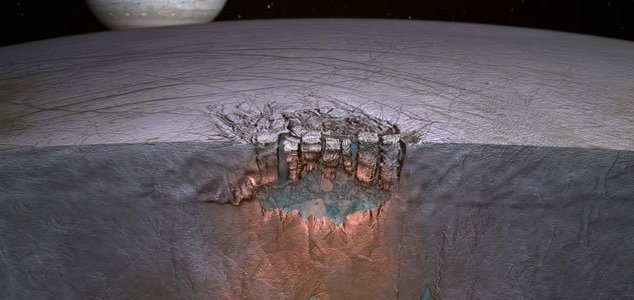Space & Astronomy
September 8, 2014 · 8 comments
8 comments

A look below the surface of Europa's icy crust. Image Credit: Britney Schmidt/Dead Pixel VFX
Now the case for life on the Jovian moon has been strengthened even further by the discovery of what appear to be tectonics involving large sections of the ice sliding underneath one another.
The revelation was based on a new analysis of images taken by NASA's Galileo spacecraft. By treating the surface ice as a huge jigsaw puzzle, researchers were able to piece together how large chunks of ice were cycling downwards from the surface to the ocean deep below the crust.
The discovery holds significance in the hunt for life because this mechanism could allow minerals and organic molecules from comets to make their way down from the surface in to the liquid ocean underneath. Previously it had been assumed that Europa's icy shell was stopping any interaction between the two environments and that they were effectively sealed off from one another.
Source: New Scientist | Comments (8)
Icy plate tectonics discovered on Europa
By T.K. RandallSeptember 8, 2014 ·
 8 comments
8 comments
A look below the surface of Europa's icy crust. Image Credit: Britney Schmidt/Dead Pixel VFX
Jupiter's freezing moon Europa is home to its own ice-based version of Earth's plate tectonics.
Considered to be one of the best places to look for evidence of life beyond our own planet, Europa consists of a thick icy shell encompassing what many scientists believe to be a deep ocean of liquid water where micro-organisms could potentially thrive.Now the case for life on the Jovian moon has been strengthened even further by the discovery of what appear to be tectonics involving large sections of the ice sliding underneath one another.
The discovery holds significance in the hunt for life because this mechanism could allow minerals and organic molecules from comets to make their way down from the surface in to the liquid ocean underneath. Previously it had been assumed that Europa's icy shell was stopping any interaction between the two environments and that they were effectively sealed off from one another.
Source: New Scientist | Comments (8)

The Unexplained Mysteries
Book of Weird News
AVAILABLE NOW
Take a walk on the weird side with this compilation of some of the weirdest stories ever to grace the pages of a newspaper.
Click here to learn more

Support us on Patreon
BONUS CONTENTFor less than the cost of a cup of coffee, you can gain access to a wide range of exclusive perks including our popular 'Lost Ghost Stories' series.
Click here to learn more
Spirituality, Religion and Beliefs
United States and the Americas
Israel, Palestine and the Middle-East
Modern Mysteries, New Age and Prophecies
Total Posts: 7,768,175 Topics: 325,018 Members: 203,763
Not a member yet ? Click here to join - registration is free and only takes a moment!
Not a member yet ? Click here to join - registration is free and only takes a moment!


































Please Login or Register to post a comment.